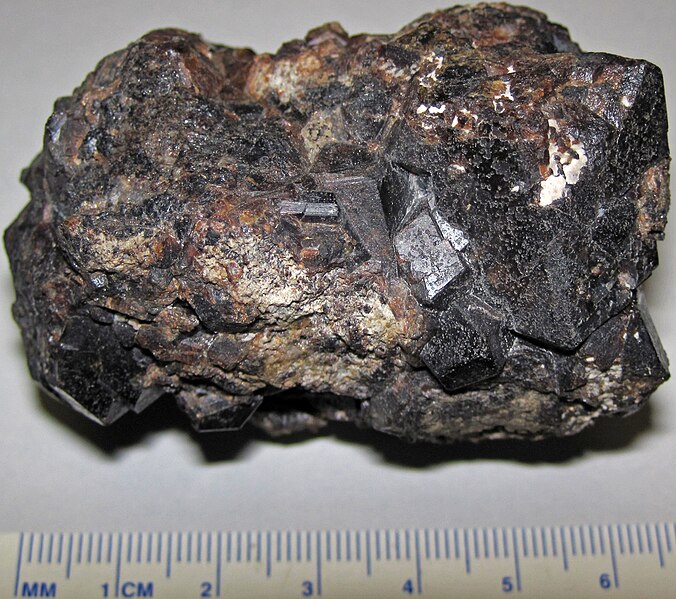File:Melanite garnets (Zacatecas, Mexico) 1.jpg

Original file (2,430 × 2,155 pixels, file size: 3.41 MB, MIME type: image/jpeg)
Captions
Captions
Summary edit
| DescriptionMelanite garnets (Zacatecas, Mexico) 1.jpg |
English: Polycrystalline melanite garnet mass from Mexico. (centimeter scale)
A mineral is a naturally-occurring, solid, inorganic, crystalline substance having a fairly definite chemical composition and having fairly definite physical properties. At its simplest, a mineral is a naturally-occurring solid chemical. Currently, there are about 5400 named and described minerals - about 200 of them are common and about 20 of them are very common. Mineral classification is based on anion chemistry. Major categories of minerals are: elements, sulfides, oxides, halides, carbonates, sulfates, phosphates, and silicates. The silicates are the most abundant and chemically complex group of minerals. All silicates have silica as the basis for their chemistry. "Silica" refers to SiO2 chemistry. The fundamental molecular unit of silica is one small silicon atom surrounded by four large oxygen atoms in the shape of a triangular pyramid - this is the silica tetrahedron - SiO4. Each oxygen atom is shared by two silicon atoms, so only half of the four oxygens "belong" to each silicon. The resulting formula for silica is thus SiO2, not SiO4. Garnet is a group of silicate minerals. Garnets are expected to be red to dark red in color - many of them are, but several garnet varieties can be other colors, including purple, orange, olive green, deep green, and black. Garnets form 12-sided crystals (dodecahedrons) or crystals with even more faces on them. The crystals become more and more rounded as the crystal face number increases. Garnet has a nonmetallic, glassy luster, whitish streak, is quite hard (H = 7), has no cleavage, and has conchoidal fracture. Common examples of garnet include almandine, grossular, spessartine, and andradite. Andradite is the most common variety of calcium garnet. Andradite is a calcium-iron garnet (Ca3Fe2Si3O12 - calcium iron silicate). It varies in color from yellowish to greenish to brownish to blackish. Green, chromium-bearing andradite is called demantoid. Black andradite is called melanite (e.g., sample shown above). Locality: unrecorded/undisclosed site in Zacatecas State, central Mexico Photo gallery of melanite garnet: www.mindat.org/gallery.php?min=7443 |
| Date | |
| Source | https://www.flickr.com/photos/47445767@N05/33344930394/ |
| Author | James St. John |
Licensing edit
- You are free:
- to share – to copy, distribute and transmit the work
- to remix – to adapt the work
- Under the following conditions:
- attribution – You must give appropriate credit, provide a link to the license, and indicate if changes were made. You may do so in any reasonable manner, but not in any way that suggests the licensor endorses you or your use.
| This image was originally posted to Flickr by James St. John at https://flickr.com/photos/47445767@N05/33344930394. It was reviewed on 28 December 2021 by FlickreviewR 2 and was confirmed to be licensed under the terms of the cc-by-2.0. |
28 December 2021
File history
Click on a date/time to view the file as it appeared at that time.
| Date/Time | Thumbnail | Dimensions | User | Comment | |
|---|---|---|---|---|---|
| current | 16:50, 28 December 2021 |  | 2,430 × 2,155 (3.41 MB) | Ser Amantio di Nicolao (talk | contribs) | Uploaded a work by James St. John from https://www.flickr.com/photos/47445767@N05/33344930394/ with UploadWizard |
You cannot overwrite this file.
File usage on Commons
There are no pages that use this file.
Metadata
This file contains additional information such as Exif metadata which may have been added by the digital camera, scanner, or software program used to create or digitize it. If the file has been modified from its original state, some details such as the timestamp may not fully reflect those of the original file. The timestamp is only as accurate as the clock in the camera, and it may be completely wrong.
| Camera manufacturer | Canon |
|---|---|
| Camera model | Canon PowerShot D10 |
| Exposure time | 1/60 sec (0.016666666666667) |
| F-number | f/9 |
| ISO speed rating | 80 |
| Date and time of data generation | 16:57, 19 April 2017 |
| Lens focal length | 7.23 mm |
| Image title | |
| Width | 4,000 px |
| Height | 3,000 px |
| Bits per component |
|
| Pixel composition | RGB |
| Orientation | Normal |
| Number of components | 3 |
| Horizontal resolution | 180 dpi |
| Vertical resolution | 180 dpi |
| Software used | Adobe Photoshop Elements 13.0 (Macintosh) |
| File change date and time | 20:56, 21 April 2017 |
| Y and C positioning | Co-sited |
| Exif version | 2.21 |
| Date and time of digitizing | 16:57, 19 April 2017 |
| Meaning of each component |
|
| Image compression mode | 3 |
| APEX shutter speed | 5.90625 |
| APEX aperture | 6.34375 |
| APEX exposure bias | −1.3333333333333 |
| Maximum land aperture | 3.34375 APEX (f/3.19) |
| Metering mode | Pattern |
| Flash | Flash fired, compulsory flash firing, red-eye reduction mode |
| Supported Flashpix version | 1 |
| Color space | sRGB |
| Focal plane X resolution | 16,460.905349794 |
| Focal plane Y resolution | 16,483.516483516 |
| Focal plane resolution unit | inches |
| Sensing method | One-chip color area sensor |
| File source | Digital still camera |
| Custom image processing | Normal process |
| Exposure mode | Manual exposure |
| White balance | Auto white balance |
| Digital zoom ratio | 1 |
| Scene capture type | Portrait |
| Lens used | 6.2-18.6 mm |
| Date metadata was last modified | 16:56, 21 April 2017 |
| Unique ID of original document | 92A5B01CF7053D0CD5927120DFE18707 |
| IIM version | 13,067 |